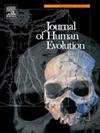坦桑尼亚Olduvai峡谷内isiusiu床型剖面的发光和放射性碳定年及中石器时代/晚石器时代过渡时期。
IF 3.1
1区 地球科学
Q1 ANTHROPOLOGY
引用次数: 0
摘要
奥都瓦伊峡谷内西苏床和恩都图床对了解智人的文化和生物进化具有重要意义。然而,人们对这些地层沉积的时间和跨度知之甚少。根据沉积岩心样品的发光测年和内西苏型剖面露头的一个鸵鸟蛋壳(OES)放射性碳测年,提出了一个年代学。Naisiusiu床型剖面位于Olduvai原峡谷底部,位于后ndutu切口表面,该切口穿过较老的Olduvai床(约80米),进入I层玄武岩顶部。估计峡谷内内西苏层的最小厚度为50 ~ 13.3 m。在9.2 m厚的类型剖面中确定了3个岩石地层单元:下部单元为河流/高密度流交替沉积,OES测年为49,728±1378 cal year BP;中间单元主要由河流沉积物组成,其中含有晚石器时代(LSA)文物和动物遗骸,年代在34.2±2.8 ka至24.0±2.0 ka之间;上部单元为火山碎屑高密度流沉积,具有层间碳酸盐胶结表面,年龄在24.0±2.0 ~ 19.6±1.6 ka之间。中间单元较慢的沉积速率(7.3 cm/ka)与河流的反复切割和充填有关。上奈西苏层叠的高密度流及其间隙的吸积速率更快(54.9 cm/ka)。下单元顶部的OES放射性碳测年为49,728±1378 cal year BP(模拟年龄= 49,498±2385 BP),表明该类型剖面延伸至> - 50 ka。LSA组合与34.2±2.8 ka的沉积物相关联。在类型位置26的下伏Ndutu层中最年轻的中石器时代的年龄为62.7±5.6 ka,这为Olduvai峡谷中石器时代/LSA过渡的最大年龄提供了依据。本文章由计算机程序翻译,如有差异,请以英文原文为准。
Luminescence and radiocarbon dating the Naisiusiu Beds type section and timing of the Middle Stone Age/Later Stone Age transition at Olduvai Gorge, Tanzania
The Olduvai Gorge Naisiusiu Beds and Ndutu Beds are significant for understanding the cultural and biological evolution of Homo sapiens. However, the timing and span of deposition of these beds is poorly understood. We present a chronology based on luminescence dates for sedimentary drill core samples and one ostrich eggshell (OES) radiocarbon date from the Naisiusiu type section outcrop. The Naisiusiu Beds type section rests on the Olduvai protogorge floor, on a post-Ndutu incisional surface that eroded through older Olduvai Beds (∼80 m) into the top of the Bed I Basalt. The estimated minimum thickness of the Naisiusiu Beds within the gorge is >13.3 m. Three lithostratigraphic units were identified in the 9.2-m-thick type section: The lower unit comprises alternating fluvial/hyperconcentrated flow sediments and yields an OES date of 49,728 ± 1378 cal year BP; the middle unit is composed of predominantly fluvial sediments containing Later Stone Age (LSA) artifacts and faunal remains, dating between 34.2 ± 2.8 ka and 24.0 ± 2.0 ka; and the upper unit comprises volcaniclastic hyperconcentrated flow deposits with interstratified carbonate-cemented surfaces, dating between 24.0 ± 2.0 ka and 19.6 ± 1.6 ka. Slower accretion rates of the middle unit (7.3 cm/ka) are associated with repeated fluvial cutting and filling. Upper Naisiusiu stacks of hyperconcentrated flows and intervening hiatuses have faster accretion rates (54.9 cm/ka). The OES radiocarbon date of 49,728 ± 1378 cal year BP (modeled age = 49,498 ± 2385 BP) from the top part of the lower unit indicates that the type section extends back to >50 ka. The LSA assemblage is associated with sediments dated to 34.2 ± 2.8 ka using luminescence. A date of 62.7 ± 5.6 ka on the youngest Middle Stone Age occurrence in the underlying Ndutu Beds at Type Locality 26 provides a maximum age for the Middle Stone Age/LSA transition at the Olduvai Gorge.
求助全文
通过发布文献求助,成功后即可免费获取论文全文。
去求助
来源期刊

Journal of Human Evolution
生物-进化生物学
CiteScore
6.30
自引率
15.60%
发文量
104
审稿时长
3 months
期刊介绍:
The Journal of Human Evolution concentrates on publishing the highest quality papers covering all aspects of human evolution. The central focus is aimed jointly at paleoanthropological work, covering human and primate fossils, and at comparative studies of living species, including both morphological and molecular evidence. These include descriptions of new discoveries, interpretative analyses of new and previously described material, and assessments of the phylogeny and paleobiology of primate species. Submissions should address issues and questions of broad interest in paleoanthropology.
 求助内容:
求助内容: 应助结果提醒方式:
应助结果提醒方式:


